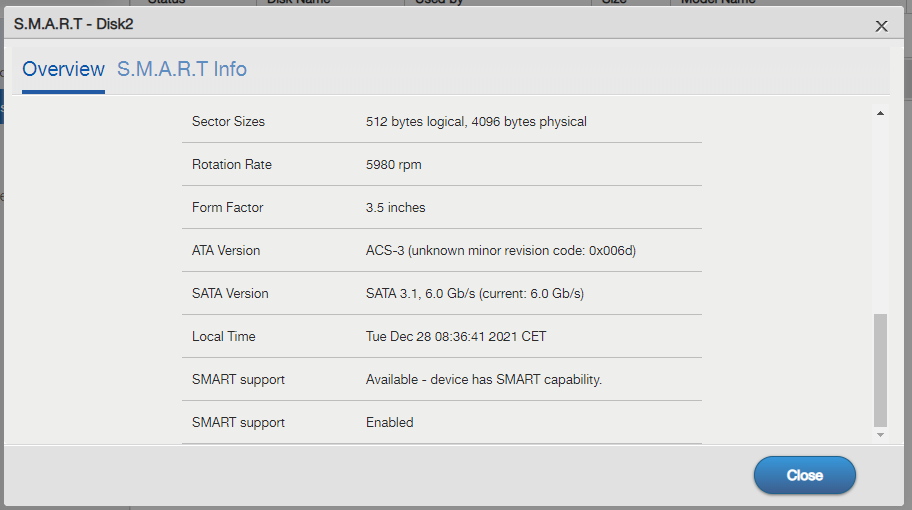Overview shows "Green Health" but Disk2 shows "Bad Health, Status: Danger" !!
Biggles
Posts: 7


With reference to my newly bought NAS326 with 2 x Seagate IronWolf 4TB.
Out of curiosity I checked the status of my Raid1 (used default setup during installation) and found that the Overview showed "Green" status on both disks, BUT when I looked into Disk2 it showed "Bad, status: Danger"!
Question: How to interprete the information given (I know something is wrong) including the S.M.A.R.T Info and how to correct it and make it good again?
Enclosed screenshots shows the information i received.










Should also mention that I deleted my first total back-up, due to "Windows File History" adding time stamps to all files, if it has any barring on the issue.
Looking forward to hear from you experts.
Regards Biggles
0
Accepted Solution
-
I don't see anything alarming.The Raw_Read_Error_Rate and Seek_Error_Rate seem a bit high, but the disk itself doesn't seem to be alarmed, seeing the threshold. You could compare it to the other disk. Further it shows the Reallocated_Sector_Cnt in the header, so maybe that is the alarming factor. 88 is not a bad value, but maybe it is growing fast, which could point to a problem. (Reallocated_Sector_Cnt is the number of spare sectors which are used to (transparently) replace bad sectors. On a total number of around 1000000000 sectors 88 isn't much, but it shouldn't grow fast.)If you have a decent backup I wouldn't panic, keep an eye on changes, and just replace the disk when it dies.how to correct it and make it good again?Assuming that it's not false alarm, a SMART error means the disk controller thinks the disk is going to die soon. That cannot be corrected, the only remedy is to replace the disk.
0
All Replies
-
I don't see anything alarming.The Raw_Read_Error_Rate and Seek_Error_Rate seem a bit high, but the disk itself doesn't seem to be alarmed, seeing the threshold. You could compare it to the other disk. Further it shows the Reallocated_Sector_Cnt in the header, so maybe that is the alarming factor. 88 is not a bad value, but maybe it is growing fast, which could point to a problem. (Reallocated_Sector_Cnt is the number of spare sectors which are used to (transparently) replace bad sectors. On a total number of around 1000000000 sectors 88 isn't much, but it shouldn't grow fast.)If you have a decent backup I wouldn't panic, keep an eye on changes, and just replace the disk when it dies.how to correct it and make it good again?Assuming that it's not false alarm, a SMART error means the disk controller thinks the disk is going to die soon. That cannot be corrected, the only remedy is to replace the disk.
0 -
Thank you @Mijzelf for a quick response,
I will compare both disks to see if anything stands out or getting worse.
Both my "Seagate IronWolf 4TB" are brand new, so should not be any problem to have them replaced. My own reflection is that it will be the first time in over 30 years that I have had problem with a HDD :-).
I wish you a Happy New Year.
0
Categories
- All Categories
- 388 Beta Program
- 2.1K Nebula
- 116 Nebula Ideas
- 78 Nebula Status and Incidents
- 5.1K Security
- 51 USG FLEX H Series
- 247 Security Ideas
- 1.3K Switch
- 69 Switch Ideas
- 913 WirelessLAN
- 34 WLAN Ideas
- 5.9K Consumer Product
- 210 Service & License
- 330 News and Release
- 71 Security Advisories
- 21 Education Center
- 5 [Campaign] Zyxel Network Detective
- 1.9K FAQ
- 874 Nebula FAQ
- 413 Security FAQ
- 220 Switch FAQ
- 193 WirelessLAN FAQ
- 46 Consumer Product FAQ
- 137 Service & License FAQ
- 34 Documents
- 34 Nebula Monthly Express
- 72 About Community
- 61 Security Highlight
 Guru Member
Guru Member


